Soil Bio-Impact Effectiveness for the Optimal Multicriterial Environmental Sustainability in Crop Production
Abstract
1. Introduction
2. Materials and Methods
2.1. Determination of the Weight of the Preferences and Optimality of Each Environmental Sustainability Criterion for Soil Bio-Impact Effect
2.2. Assessment of Optimal Multicriterial Environmental Sustainability in Crop Production
2.3. Statistical Analysis
3. Results and discussion
3.1. Ploughing Fuel Consumption Dependence on Optimal Bio-Impact(s) Time (Year) and Scenario
3.2. Disc Harrowing Fuel Consumption Dependence on Optimal Bio-Impact(s) Time (Year) and Scenario
3.3. CO2 from Soil Dependence on Optimal Bio-Impact(s) Time (Year) and Scenario
3.4. Elected Soil Characteristics (Density, Total Porosity, Humus, Stability, Moisture) Dependence on Optimal Bio-Impact(s) Time (Year) and Scenario
3.5. Multicriteria Evaluation of the Optimal Bio-Impact Effectiveness for Environmental Sustainability
- (1)
- Ploughing fuel consumption (L h–1), disc harrowing fuel consumption (L h–1), and yield (t ha–1);
- (2)
- CO2 from soil (µmol m2 s–1) and soil density (g cm3) and total porosity (%);
- (3)
- Soil humus (%), soil stability (%), and soil moisture content (%).
4. Conclusions
Author Contributions
Funding
Conflicts of Interest
References
- Khattab, R.Y.; Arntfield, S.D.; Nyachoti, C.M. Nutritional quality of legume seeds as affected by some physical treatments, Part 1: Protein quality evaluation. LWT-Food Sci. Technol. 2009, 42, 1107–1112. [Google Scholar] [CrossRef]
- Banerjee, D. Endophytic fungal diversity in tropical and subtropical plants. Res. J. Microbiol. 2011, 6, 54–62. [Google Scholar] [CrossRef]
- Jakienė, E. Effect of biological products on sugar–beet crop. Agricultural sciences. Effects of organic products on sugar beet crops. Agric. Sci. 2011, 18, 64–71. [Google Scholar]
- Vaitauskienė, K.; Šarauskis, E.; Naujokienė, V.; Liakas, V. The influence of free–living nitrogen–fixing bacteria on the mechanical characteristics of different plant residues under no–till and strip–till conditions. In Soil and Tillage Research; Elsevier: Amsterdam, The Netherlands, 2015; Volume 154, pp. 91–102. [Google Scholar]
- Blaszczyk, L.; Siwulski, M.; Sobieralski, K.; Lisiecka, J.; Jedryczka, M. Trichoderma spp.–Application and prospects for use in organic farming and industry. J. Plant Prot. Res. 2014, 54, 309–317. [Google Scholar] [CrossRef]
- Atanasova, L.; Crom, S.; Gruber, S.; Coulpier, F.; Seidl-Seiboth, V.; Kubicek, C.; Druzhinina, I.S. Comparative transcriptomics reveals different strategies of Trichodermamycoparasitism. BMC Genom. 2013, 14, 121. [Google Scholar] [CrossRef]
- Oskiera, M.; Szczecha, M.; Stępowska, A.; Smolińska, U.; Bartoszewskic, G. Monitoring of Trichoderma species in agricultural soil in response to application of biopreparations. Biol. Control 2017, 113, 65–72. [Google Scholar] [CrossRef]
- Santos, C.A.; Caldeira, M.L.; Lopes da Silva, T.; Novais, J.M.; Reis, A. Enhanced lipidic algae biomass production using gas transfer from a fermentative Rhodosporidium toruloides culture to an autotrophic Chlorella protothecoides culture. Bioresour. Technol. 2013, 138, 48–54. [Google Scholar] [CrossRef]
- Chachina, S.B.; Voronkova, N.A.; Baklanova, O.N. Biological Remediation of the Petroleum and Diesel Contaminated Soil with Earthworms Eisenia Fetida. Procedia Eng. 2016, 152, 122–133. [Google Scholar] [CrossRef]
- Sathiyabama, M.; Parthasarathy, R. Biological preparation of chitosan nanoparticles and its in vitro antifungal efficacy against some phytopathogenic fungi. Carbohydr. Polym. 2016, 151, 321–325. [Google Scholar] [CrossRef]
- Liu, Y.; Xing, Z.; Yang, H. Effect of biological soil crusts on microbial activity in soils of the Tengger Desert (China). J. Arid. Environ. 2017, 144, 201–211. [Google Scholar] [CrossRef]
- Montemurro, F.; Ferri, D.; Tittarelli, F.; Canali, S.; Vitti, C. Anaerobic Digestate and On-Farm Compost Application: Effects on Lettuce (Lactuca sativa L.) Crop Production and Soil Properties. Compost Sci. Util. 2010, 18, 184–193. [Google Scholar] [CrossRef]
- Kieliszek, M.; Kot, A.M.; Bzducha-Wróbel, A.; Błażejak, S.; Gientka, I.; Kurcz, A. Biotechnological use of Candida yeasts in the food industry: A review. Fungal Biol. Rev. 2017, 31, 185–198. [Google Scholar] [CrossRef]
- Cabala, P. Using the analytic hierarchy process in evaluating decision alternatives. In Operations Research and Decisions; Wroclaw University of Technology: Wroclaw, Poland, 2010; Volume 1, pp. 1–23. [Google Scholar]
- Bystrzanowska, M.; Tobiszewski, M. How can analysts use multicriteria decision analysis? Trends Anal. Chem. 2018, 105, 98–105. [Google Scholar] [CrossRef]
- Niyigena, C.; Amziane, S.; Chateauneuf, A. Multicriteria analysis demonstrating the impact of shiv on the properties of hemp concrete. Constr. Build. Mater. 2018, 160, 211–222. [Google Scholar] [CrossRef]
- Skafa, L.; Buonocorea, E.; Dumonteta, S.; Capone, R.; Franzesea, P.P. Food security and sustainable agriculture in Lebanon: An environmental accounting framework. J. Clean. Prod. 2018, 209, 1025–1032. [Google Scholar] [CrossRef]
- Uitto, A.; Saloranta, S. Subject Teachers as Educators for Sustainability: A Survey Study. Educ. Sci. 2017, 7, 8. [Google Scholar] [CrossRef]
- Zervaa, A.; Tsantopoulos, G.; Grigoroudis, E.; Arabatzisa, G. Perceived citizens’ satisfaction with climate change stakeholders using a multicriteria decision analysis approach. Environ. Sci. Policy 2018, 82, 60–70. [Google Scholar] [CrossRef]
- Kirppua, H.; Lahdelma, R.; Salminend, P. Multicriteria evaluation of carbon-neutral heat-only production technologies for district heating. Appl. Therm. Eng. 2018, 130, 466–476. [Google Scholar] [CrossRef]
- Houshyar, E.; Grundmann, P. Environmental impacts of energy use in wheat tillage systems: A comparative life cycle assessment (LCA) study in Iran. Energy 2017, 122, 11–24. [Google Scholar] [CrossRef]
- Kole, C. Cereals and Millets; Springer: Berlin/Heidelberg, Germany, 2015. [Google Scholar]
- MAJ. Ministry of Jihad-e-Agriculture of Iran. Annual Agricultural Statistics. Available online: www.maj.ir (accessed on 1 December 2020).
- Bystrzanowska, M.; Pena-Pereira, F.; Marcinkowski, L.; Tobiszewski, M. How green are ionic liquids?—A multicriteria decision analysis approach. Ecotoxicol. Environ. Saf. 2019, 174, 455–458. [Google Scholar] [CrossRef]
- Naujokienė, V.; Šarauskis, E.; Lekavičienė, K.; Adamavičienė, A.; Buragienė, S.; Kriaučiūnienė, Z. The influence of biopreparations on the reduction of energy consumption and CO2 emissions in shallow and deep soil tillage. Sci. Total Environ. 2018, 626, 1402–1413. [Google Scholar] [CrossRef] [PubMed]
- Saaty, T.L. Making and validating complex decisions with the ahp/anp. J. Syst. Sci. Syst. Eng. 2005, 14, 1–36. [Google Scholar] [CrossRef]
- Aupetit, B.; Genest, C. On some useful properties of the Perron eigenvalue of a positive reciprocal matrix in the context of the analytic hierarchy process. Eur. J. Oper. Res. 1993, 70, 263–268. [Google Scholar] [CrossRef]
- Hossain, M.F.; Adnan, Z.H.; Hasin, M.A.A. Improvement in weighting assignment process in Analytic Hierarchy Process by introducing suggestion matrix and Likert scale. Int. J. Supply Chain Manag. 2014, 3, 91–95. [Google Scholar]
- De Feo, L.; Kieffer, J.; Smith, B. Towards Practical Key Exchange from Ordinary Isogeny Graphs. In ASIACRYPT 2018: Advances in Cryptology—ASIACRYPT 2018, Proceedings of the International Conference on the Theory and Application of Cryptology and Information Security, Brisbane, QLD, Australia, 2–6 December 2018; Springer: Cham, Germany, 2018; Volume 11274, pp. 365–394. [Google Scholar]
- Mohammadi, S.J.; Sarmadian, F.; Jafarzadeh, A.A.; Ghorbani, M.A.; Shahbazi, F. Application of SAW, TOPSIS and fuzzy TOPSIS models in cultivation priority planning for maize, rapeseed and soybean crops. Geoderma 2018, 310, 178–190. [Google Scholar] [CrossRef]
- Janssen, R. On the use of multi-criteria analysis in environmental impact assessment in The Netherlands. J. Multi-Criteria Decis. Anal. 2001, 10, 101–109. [Google Scholar] [CrossRef]
- Podvezko, V. The Comparative analysis of MCDA methods SAW and COPRAS. Eng. Econ. 2011, 22, 134–146. [Google Scholar] [CrossRef]
- Jovanovic, S.; Savic, S.; Jovicic, N.; Boskovic, G.; Djordjevic, Z. Using multi-criteria decision making for selection of the optimal strategy for municipal solid waste management. Waste Manag. Res. 2016, 34, 884–895. [Google Scholar] [CrossRef]
- Podviezko, A.; Podvezko, V. Influence of Data Transformation on Multicriteria Evaluation Result. Procedia Eng. 2015, 122, 151–157. [Google Scholar] [CrossRef]
- Vafaei, N.; Ribeiro, R.; Camarinha-Matos, L. Normalization Techniques for Multi–Criteria Decision Making: Analytical Hierarchy Process Case Study. In Doctoral Conference on Computing, Electrical and Industrial Systems; Springer: Cham, Germany, 2016; pp. 261–269. [Google Scholar] [CrossRef]
- Obriot, F.; Stauffer, M.; Delaunay, Y.G.; Cheviron, N.; Peres, G. Multi-criteria indices to evaluate the effects of repeated organic amendment applications on soil and crop quality. Agric. Ecosyst. Environ. 2016, 232, 165–178. [Google Scholar] [CrossRef]
- Chakraborty, S.; Yeh, C.H. A simulation based comparative study of normalization procedures in multiattribute decision making. In AIKED’07 Proceedings of the 6th Conference on 6th WSEAS International Conference on Artificial Intelligence, Knowledge Engineering and Data Bases; WSEAS: Stevens Point, WI, USA, 2007; Volume 6, pp. 102–109. [Google Scholar]
- Hoseini, R.; Mohammadi, E.; Kalatejari, S. Effect of bio-fertilizer on growth, development and nutrient content (leaf and soil) of Stevia rebaudiana Bertoni. J. Crop Prot. 2015, 4, 691–704. [Google Scholar]
- Dogan, N.; Akinci, Ş. Effects of water stress on the uptake of nutrients by bean seedlings (Phaseolus vulgaris L.). Fresenius Environ. Bull. 2011, 20, 2163–2170. [Google Scholar]
- Moridi, A.; Zarei, M.; Moosavi, A.A.; Ronaghi, A. Influence of PGPR-enriched liquid organic fertilizers on the growth and nutrients uptake of maize under drought condition in calcareous soil. J. Plant Nutr. 2019, 42, 2745–2756. [Google Scholar] [CrossRef]
- Álvarez, S.P.; Ardisana, E.F.H.; Leal, R.P. Plant Biotechnology for Agricultural Sustainability. In Resources Use Efficiency in Agriculture; Springer: Singapore, 2020; pp. 389–425. [Google Scholar]
- Novikova, I.; Popova, E.V.; Kolesnikov, L.E.; Priyatkin, N.S.; Kolesnikova, Y.R. Biological effectiveness of polyfunctional biopreparations in soft wheat cultivation and assessment of crop quality based on NDVI index. In BIO Web of Conferences; EDP Sciences: Les Ulis, France, 2020; Volume 18. [Google Scholar] [CrossRef][Green Version]
- Churilov, D.; Polischuk, S.; Churilov, G.; Shemyakin, A.; Churilova, V.; Andreev, K.; Arapov, I.; Obidina, I. The possibility of using biopreparations based on nanoparticles of biogenic metals in crop production and plant protection. In IOP Conference Series: Earth and Environmental Science, Proceedings of the International AgroScience Conference (AgroScience-2019), Cheboksary, Russia, 1–2 June 2019; IOP Publishing: Bristol, UK, 2019; Volume 433. [Google Scholar]
- Kolesnikov, L.E.; Novikova, I.I.; Popova, E.V.; Priyatkin, N.S.; Zuev, E.V.; Kolesnikova, Y.u.R.; Solodyannikov, M.D. The effectiveness of biopreparations in soft wheat cultivation and the quality assessment of the grain by the digital X-ray imaging. Agron. Res. 2020, 18, 2436–2448. [Google Scholar] [CrossRef]
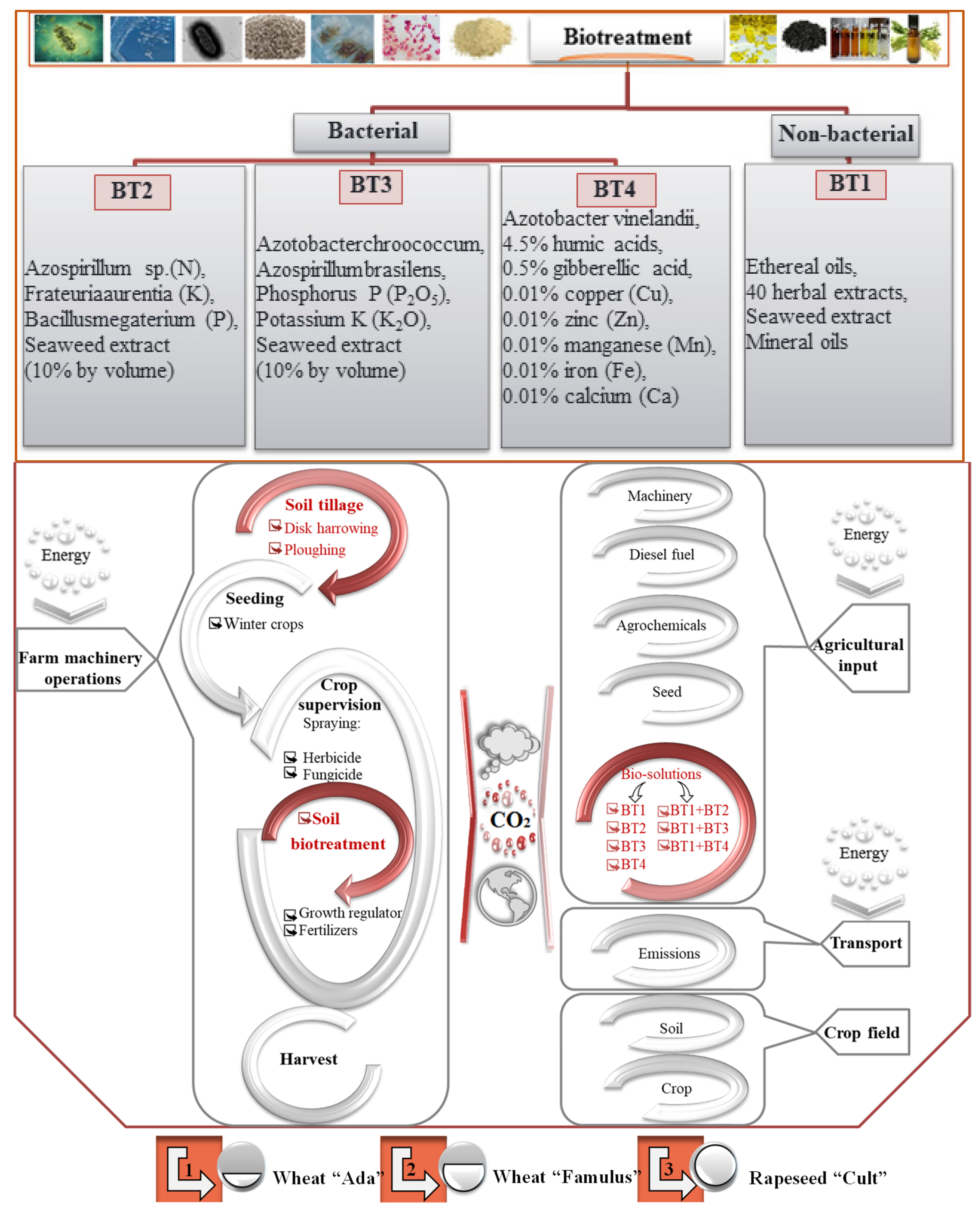
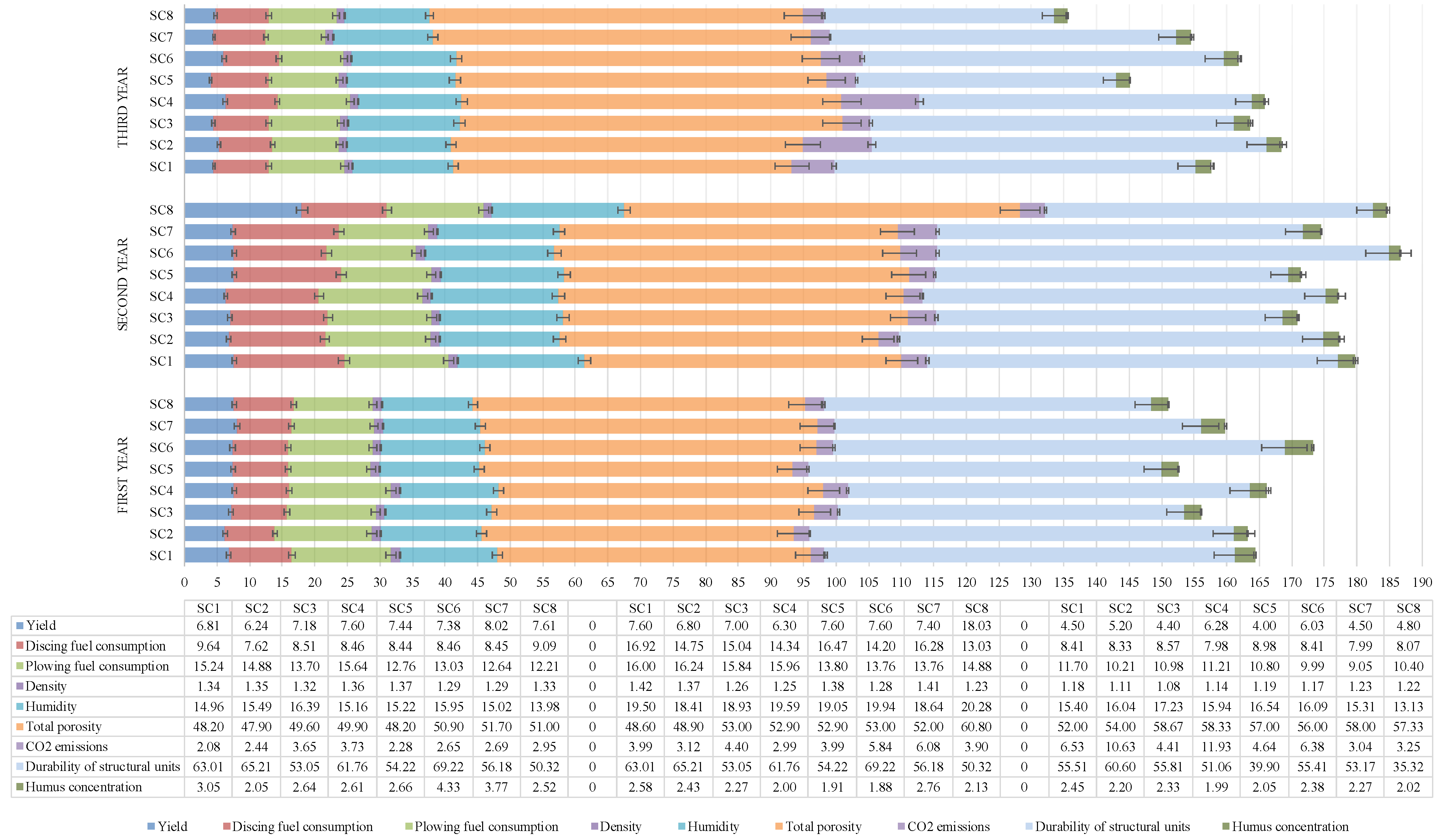

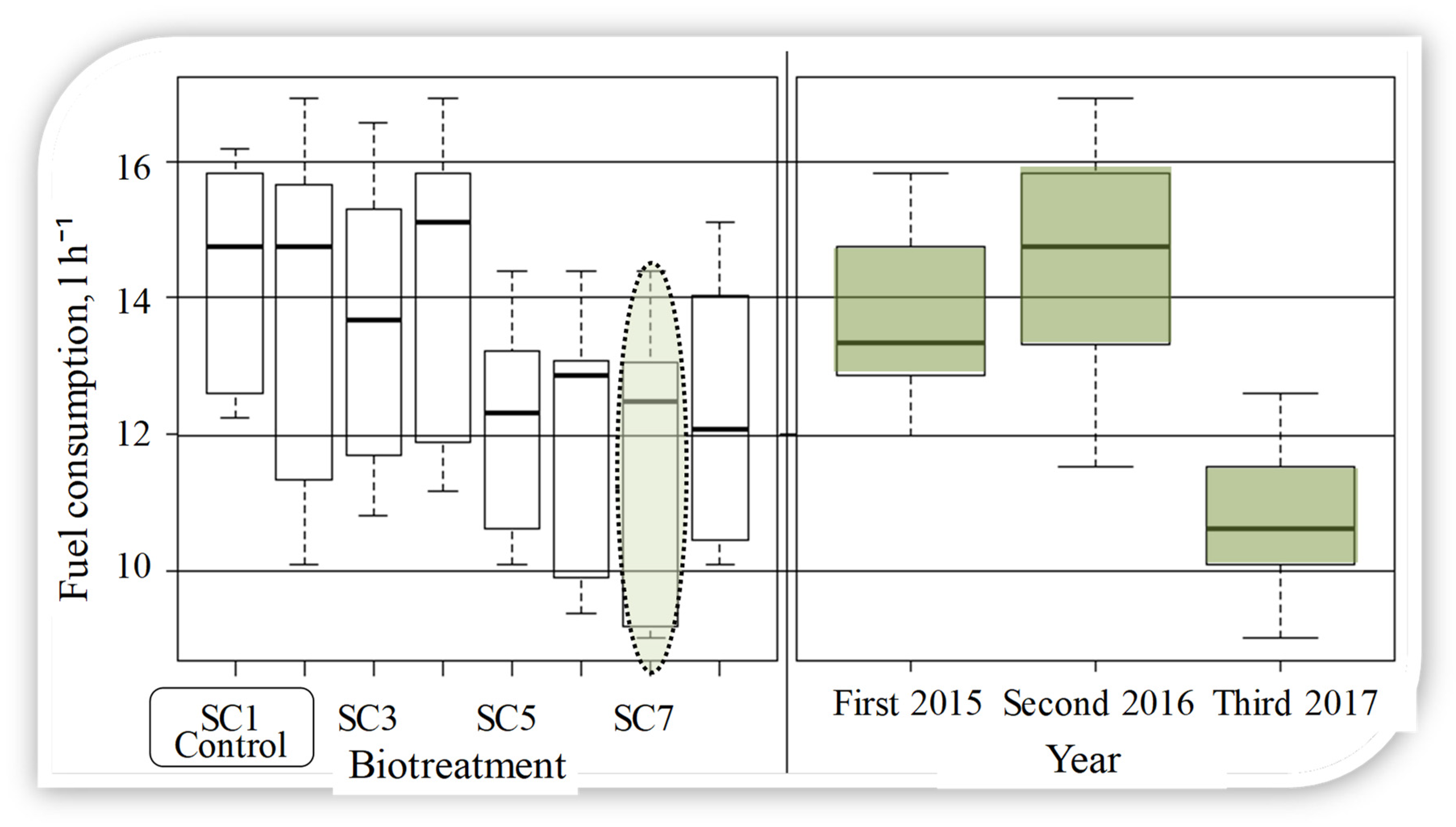
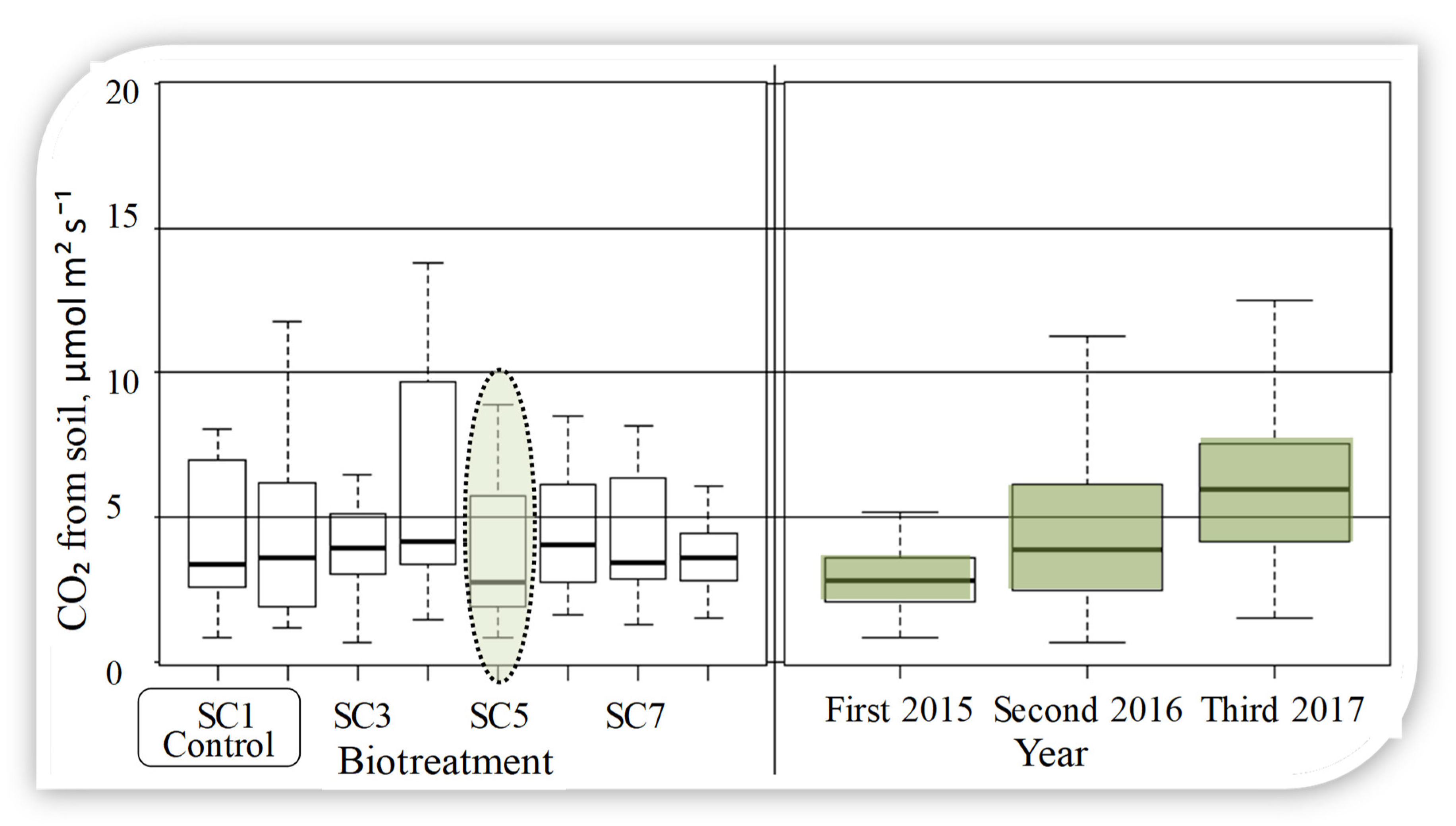

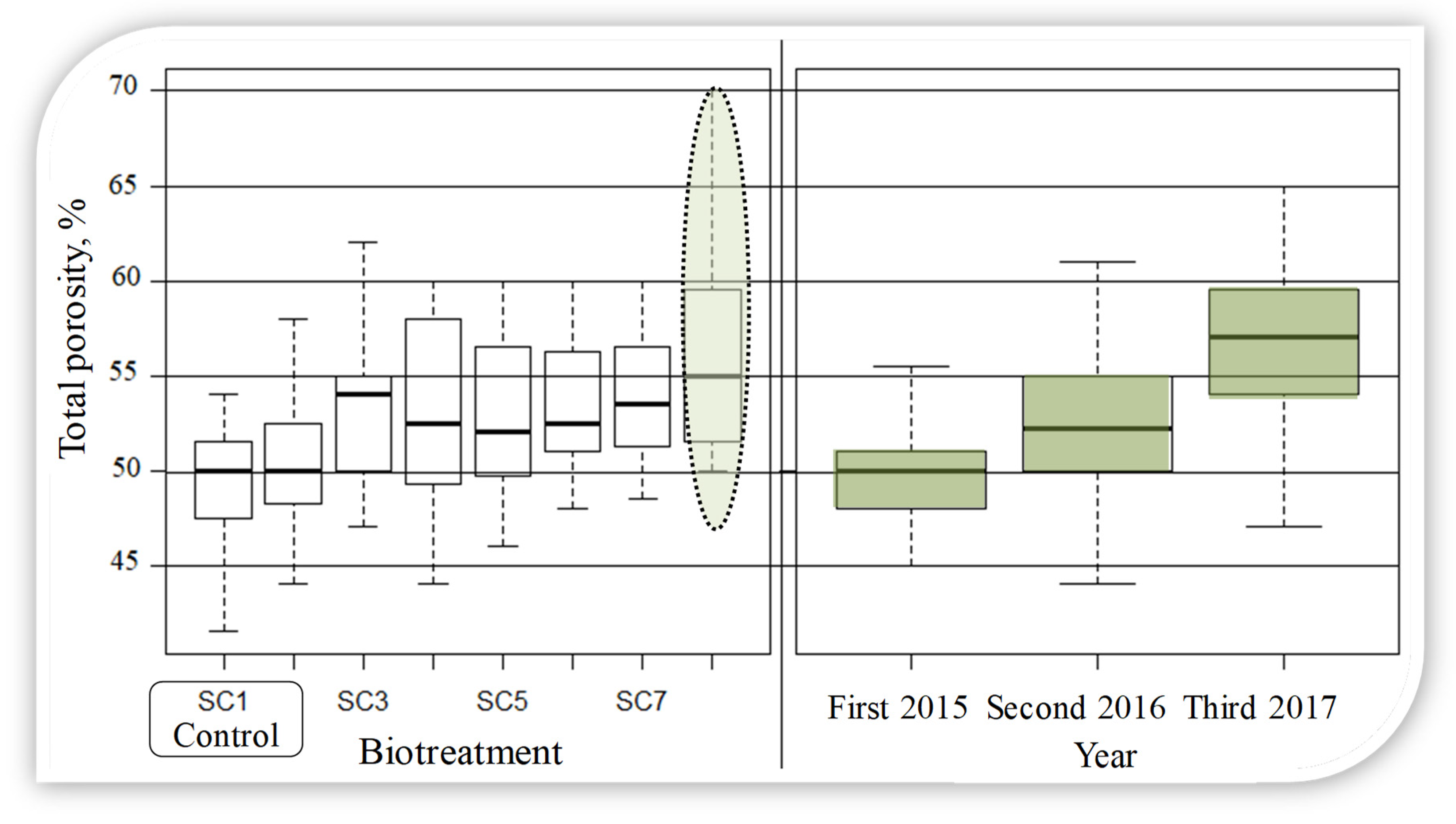
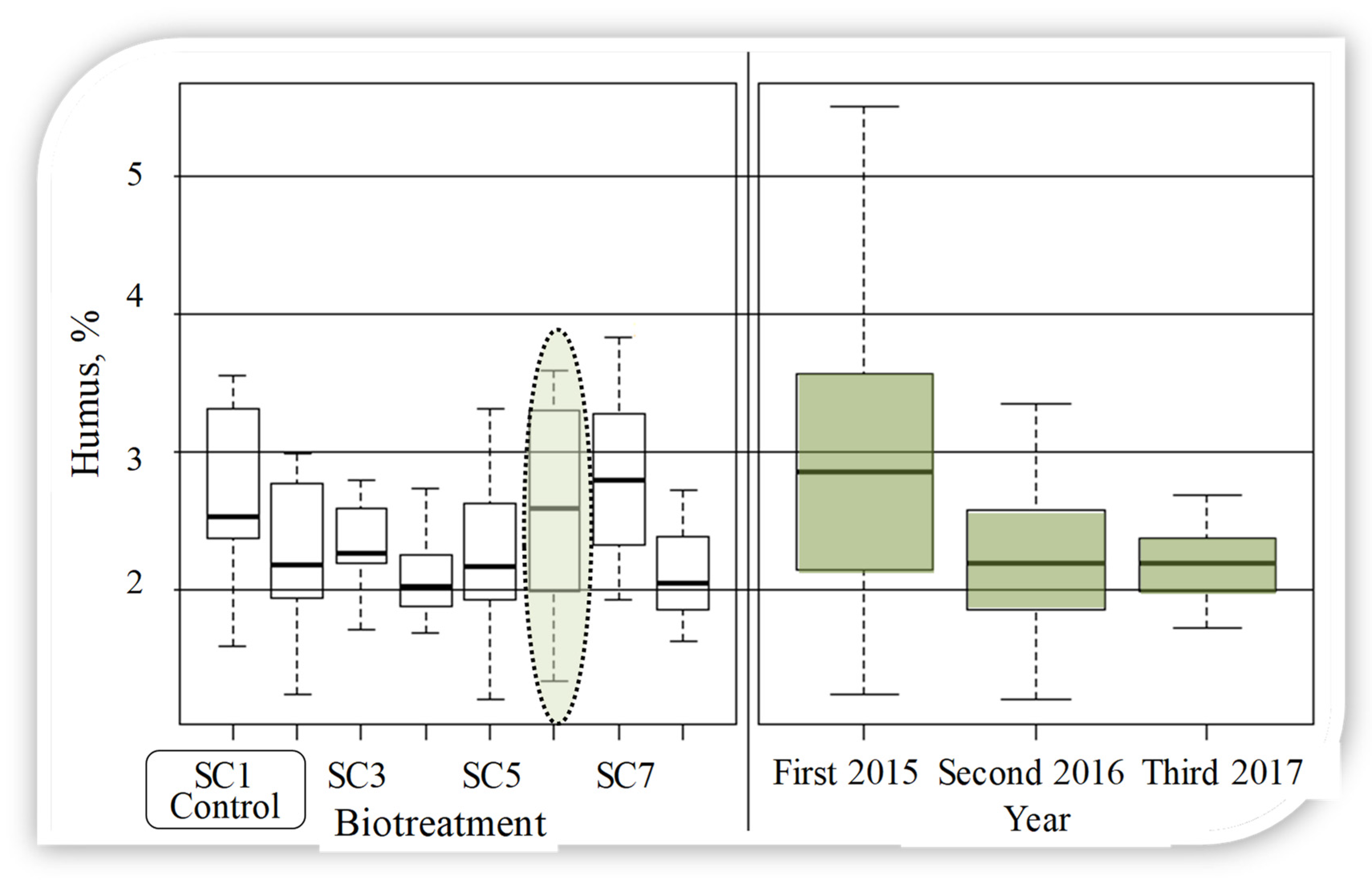

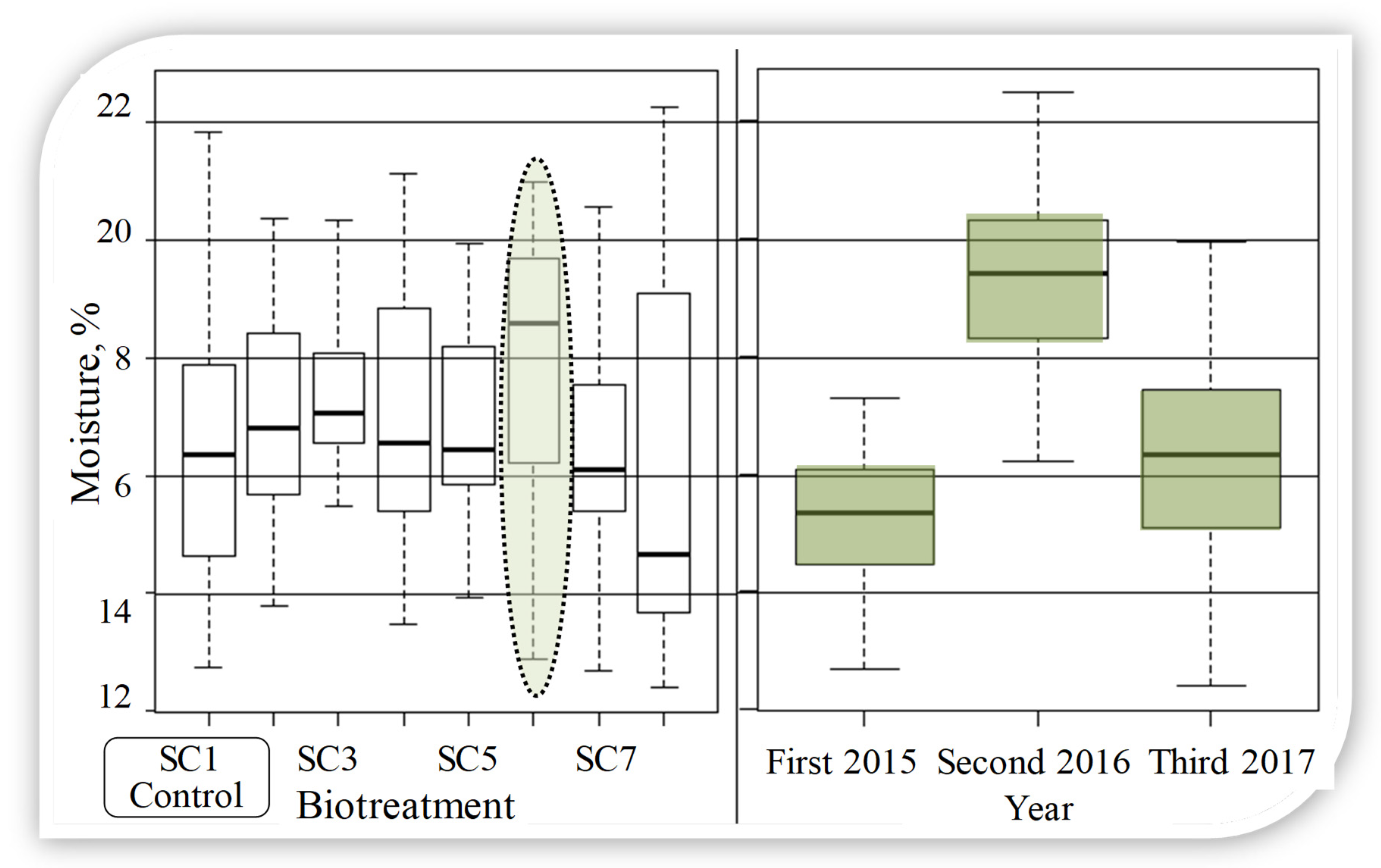
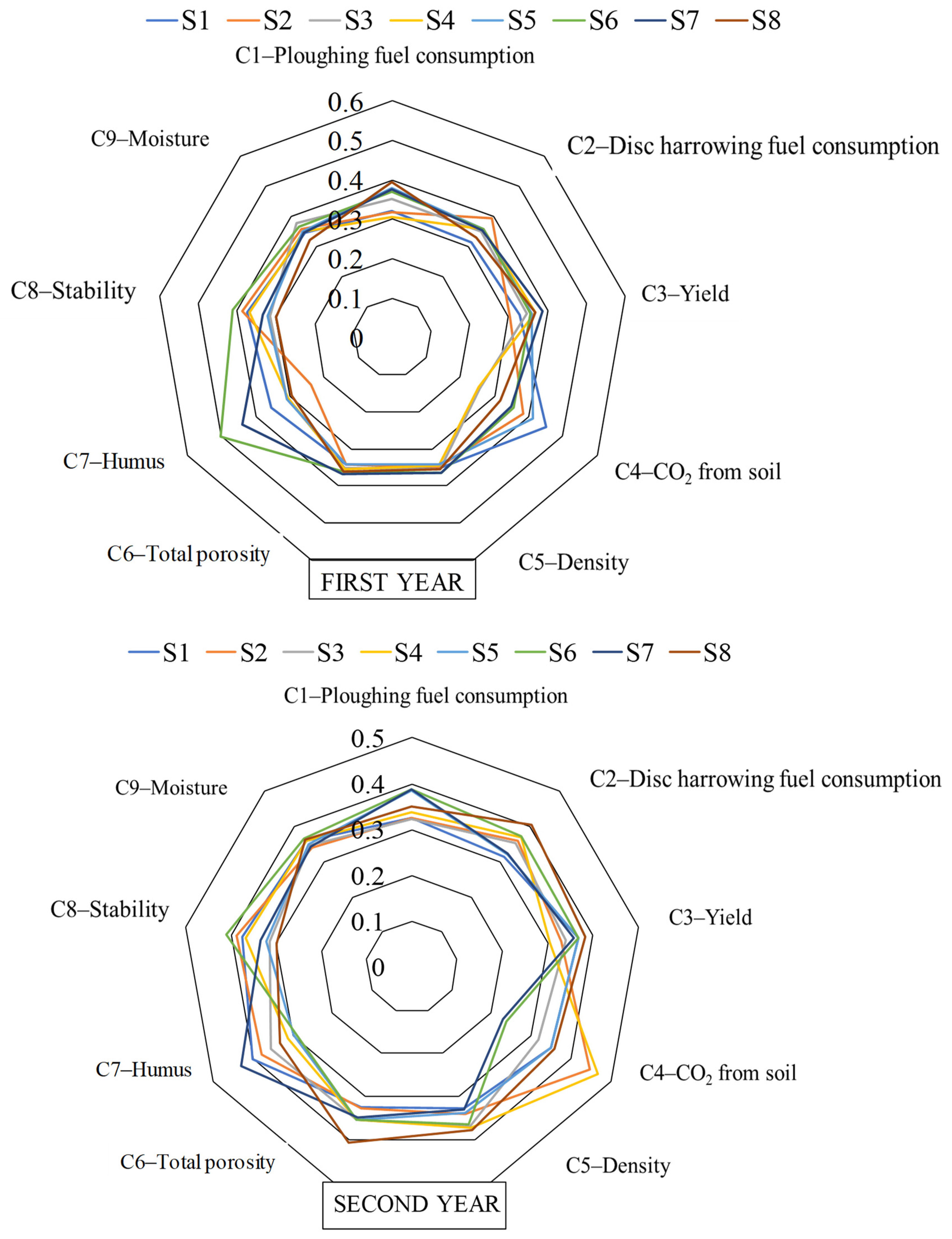
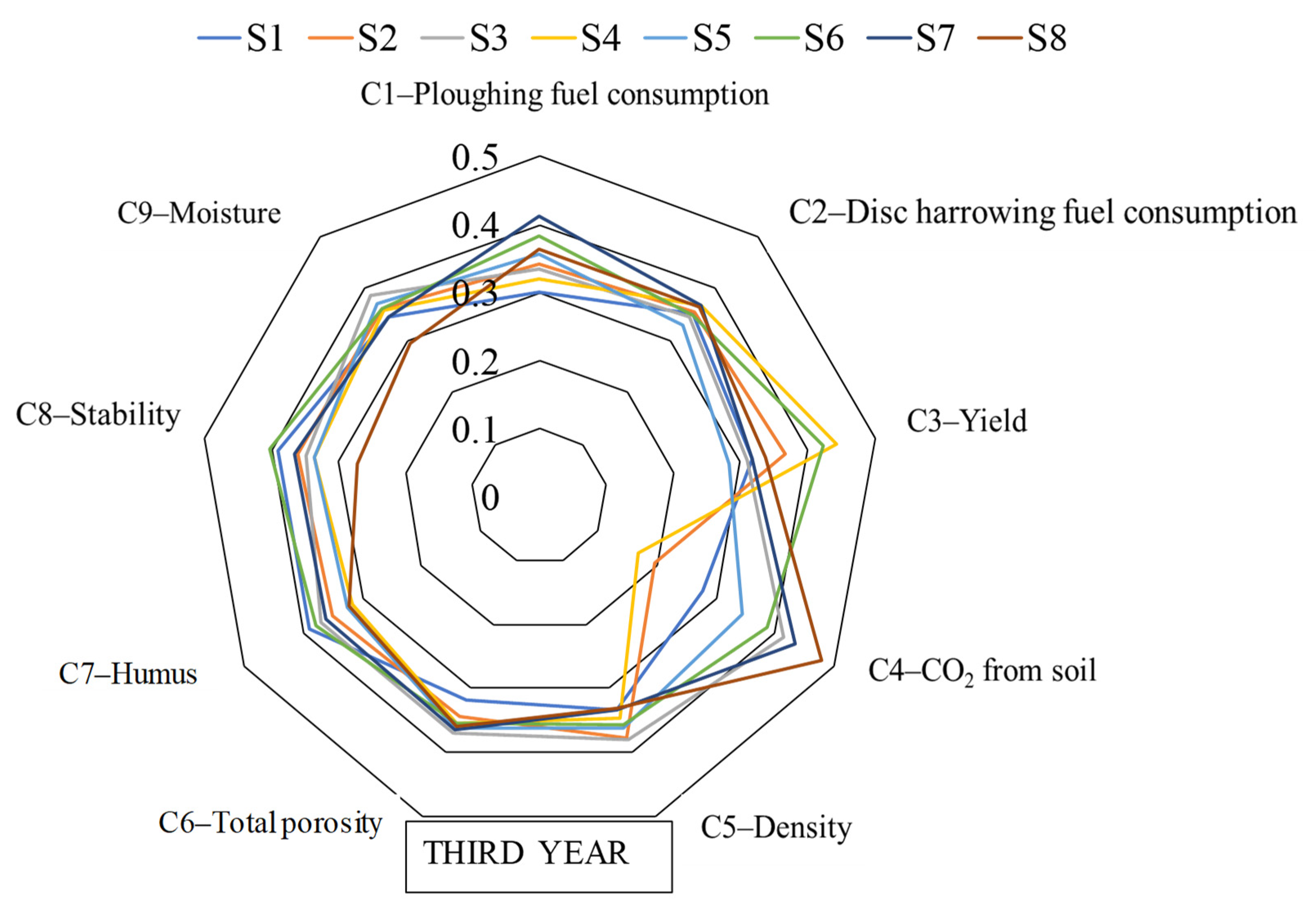
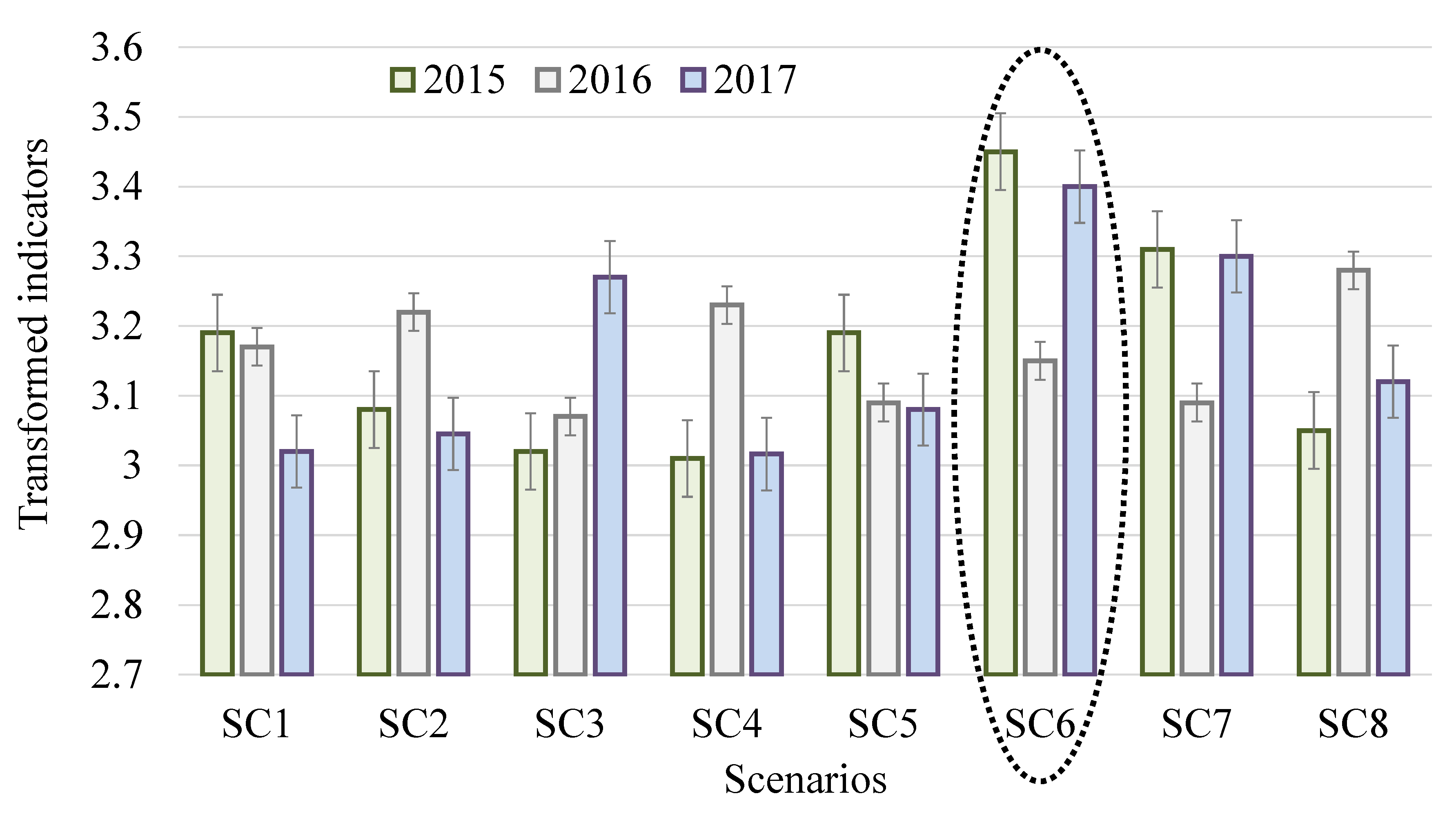
| Operations | Water Spraying | BT1 | BT2 | BT3 | BT4 | BT1 + BT2 | BT1 + BT3 | BT1 + BT4 |
|---|---|---|---|---|---|---|---|---|
| Winter wheat “Ada” (the first year)/“Famulus” (the second year)/rapeseed “Cult” (the third year) seeding | + | + | + | + | + | + | + | + |
| Biopreparations spraying | – | + | + | + | + | + | + | + |
| Control Scenario SC1 | + | – | – | – | – | – | – | – |
| Biotreatment Scenario SC2 | – | + | – | – | – | – | – | – |
| Biotreatment Scenario SC3 | + | – | – | – | – | – | ||
| Biotreatment Scenario SC4 | – | – | – | + | – | – | – | – |
| Biotreatment Scenario SC5 | – | – | – | – | + | – | – | – |
| Biotreatment Scenario SC6 | – | – | – | – | – | + | – | – |
| Biotreatment Scenario SC7 | – | – | – | – | – | – | + | – |
| Biotreatment Scenario SC8 | – | – | – | – | – | – | – | + |
| Harvest | + | + | + | + | + | + | + | + |
| Disc harrowing | + | + | + | + | + | + | + | + |
| Ploughing | + | + | + | + | + | + | + | + |
| Description of Criteria | Indicators Used | Code | Type of Criteria |
|---|---|---|---|
| Energy consumption | Fuel consumption from ploughing operation, L h−1 | C1 | Less is better |
| Fuel consumption from disc harrowing operation, L h−1 | C2 | Less is better | |
| Productivity | Grain yield (Winter wheat “Ada” (the first year)/“Famulus” (the second year)/rapeseed “Cult” (the third year), t ha−1 | C3 | More is better |
| Main influencing soil parameters | CO2 from soil, µmol m2 s−1 | C4 | Less is better |
| Soil density g cm−3 | C5 | Less is better | |
| Soil total porosity, % | C6 | More is better | |
| Soil humus, % | C7 | More is better | |
| Soil stability, % | C8 | More is better | |
| Soil moisture, % | C9 | Optimal 20% |
| Criteria Weight | 0.1905 | 0.1905 | 0.1905 | 0.0952 | 0.0952 | 0.0952 | 0.0476 | 0.0476 | 0.0476 |
|---|---|---|---|---|---|---|---|---|---|
| Indicator | C1 | C2 | C3 | C4 | C5 | C6 | C7 | C8 | C9 |
| C1 | 1 | 1 | 1 | 2 | 2 | 2 | 4 | 4 | 4 |
| C2 | 1 | 1 | 1 | 2 | 2 | 2 | 4 | 4 | 4 |
| C3 | 1 | 1 | 1 | 2 | 2 | 2 | 4 | 4 | 4 |
| C4 | 0.5 | 0.5 | 0.5 | 1 | 1 | 1 | 2 | 2 | 2 |
| C5 | 0.5 | 0.5 | 0.5 | 1 | 1 | 1 | 2 | 2 | 2 |
| C6 | 0.5 | 0.5 | 0.5 | 1 | 1 | 1 | 2 | 2 | 2 |
| C7 | 0.25 | 0.25 | 0.25 | 0.5 | 0.5 | 0.5 | 1 | 1 | 1 |
| C8 | 0.25 | 0.25 | 0.25 | 0.5 | 0.5 | 0.5 | 1 | 1 | 1 |
| C9 | 0.25 | 0.25 | 0.25 | 0.5 | 0.5 | 0.5 | 1 | 1 | 1 |
| 2015 | 1 | |||
| 2016 | −0.39 | 1 | ||
| 2017 | 0.68 | −0.43 | 1 | |
| Total | 0.59 | −0.04 | 0.76 | 1 |
| 2015 | 2016 | 2017 | Total | |
| SC1 | 3 | 5 | 7 | 8 |
| SC2 | 5 | 3 | 6 | 7 |
| SC3 | 7 | 8 | 3 | 5 |
| SC4 | 8 | 2 | 8 | 6 |
| SC5 | 4 | 7 | 5 | 4 |
| SC6 | 1 | 4 | 1 | 1 |
| SC7 | 2 | 6 | 2 | 3 |
| SC8 | 6 | 1 | 4 | 2 |
Publisher’s Note: MDPI stays neutral with regard to jurisdictional claims in published maps and institutional affiliations. |
© 2020 by the authors. Licensee MDPI, Basel, Switzerland. This article is an open access article distributed under the terms and conditions of the Creative Commons Attribution (CC BY) license (http://creativecommons.org/licenses/by/4.0/).
Share and Cite
Naujokienė, V.; Rimkuvienė, D.; Šarauskis, E. Soil Bio-Impact Effectiveness for the Optimal Multicriterial Environmental Sustainability in Crop Production. Agronomy 2021, 11, 72. https://doi.org/10.3390/agronomy11010072
Naujokienė V, Rimkuvienė D, Šarauskis E. Soil Bio-Impact Effectiveness for the Optimal Multicriterial Environmental Sustainability in Crop Production. Agronomy. 2021; 11(1):72. https://doi.org/10.3390/agronomy11010072
Chicago/Turabian StyleNaujokienė, Vilma, Daiva Rimkuvienė, and Egidijus Šarauskis. 2021. "Soil Bio-Impact Effectiveness for the Optimal Multicriterial Environmental Sustainability in Crop Production" Agronomy 11, no. 1: 72. https://doi.org/10.3390/agronomy11010072
APA StyleNaujokienė, V., Rimkuvienė, D., & Šarauskis, E. (2021). Soil Bio-Impact Effectiveness for the Optimal Multicriterial Environmental Sustainability in Crop Production. Agronomy, 11(1), 72. https://doi.org/10.3390/agronomy11010072







